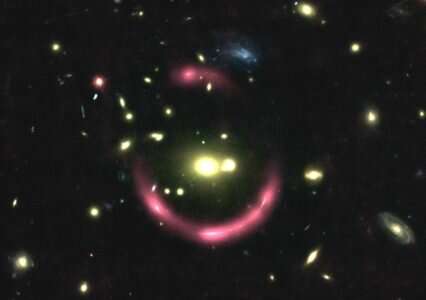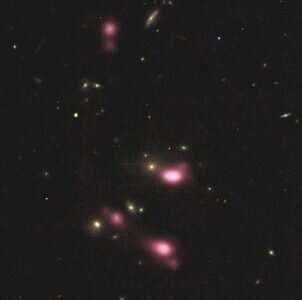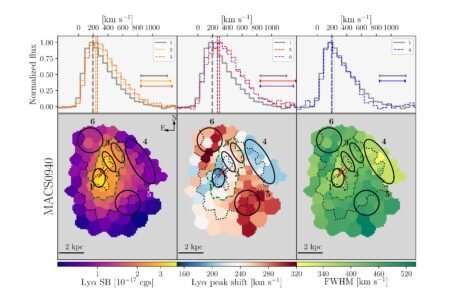Observations taken with the NASA/ESA Hubble Space Telescope of two magnified galaxies behind massive galaxy clusters: the pink glowing haloes reveal the gas surrounding the distant galaxies and its structure. The gravitational lensing effect from the clusters multiplies the images of the galaxies, producing up to 4 images of the same source. Credit: ESO / NASA / ESA / A.Claeyssens
The MUSE instrument on ESO's Very Large Telescope in Chile has revealed very detailed halos of neutral hydrogen around distant galaxies. A new result zooms on a few such halos, one of them forming a large, almost-complete ring of light. This result will be presented by Adélaïde Claeyssens (Centre de Recherche Astrophysique de Lyon—CRAL UMR5574) at the annual meeting of the European Astronomical Society (EWASS2019) in Lyon, on 25 June.
Galaxies are surrounded by copious amounts of neutral hydrogen in a region extending very far away from their center. This region is very important as it is the location of the exchanges of gas between galaxies and their environment, and a key element to understand galaxy formation and evolution. In distant galaxies, this region can be revealed through the glow of the gas emission in a halo.
The MUSE instrument, in operation on the Very Large Telescope of the European Southern Observatory, is extremely efficient at identifying halos around almost all distant galaxies it observed, but they are generally too small to show any detail or structure. The new study combined the power of MUSE with the so-called gravitational lensing effect of galaxy clusters.
Adélaïde Claeyssensexplains: "Indeed, massive clusters have the property to bend light rays passing through their center, as predicted by Einstein. This produces the effect of a magnifying glass: the images of background galaxies are magnified."
-
Observations taken with the NASA/ESA Hubble Space Telescope of two magnified galaxies behind massive galaxy clusters: the pink glowing haloes reveal the gas surrounding the distant galaxies and its structure. The gravitational lensing effect from the clusters multiplies the images of the galaxies, producing up to 4 images of the same source. Credit: ESO / NASA / ESA / A.Claeyssens
-
Example map of the spatial properties of hydrogen gas: MUSE observations reveal significant variations of the gas properties across the halo, enabling us to study in details its complex structure and the physical process at play. Credit: ESO /Claeyssens
The study presents the two most spectacular observations of magnified halos obtained to date with MUSE; in one case the halo presents the form of a large, almost-complete ring of light. By zooming on such hydrogen halos surrounding galaxies, it is possible for the first time to study with unprecedented detail how the gas properties vary across the halo. This information is critical for understanding the physical processes at play in the halo, that is, how homogeneous it is and how the gas moves around the galaxy.
This discovery demonstrates the potential of MUSE combined with the lensing effects to study many more such halos and to acquire a detailed view about galaxy formation in the universe, when it was only a few billion years old.
Provided by EWASS


























